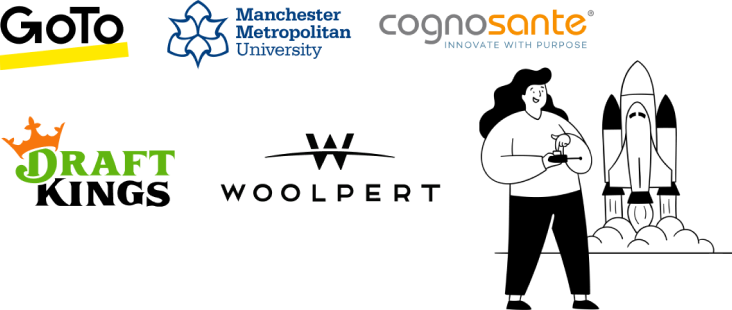
How to Implement Knowledge AI for Automating Repetitive Employee Queries

�‘What’s the status of my request for a new laptop?’
A help desk agent who has just joined a call is as clueless as you are.
It’s a long wait time for the requester until the agent searches for ticket history and returns with the correct status info.
What else?
Instantaneous, real-time, yet factual information is a tough challenge for organizations, forcing them to struggle to meet employee expectations.
When thinking about employee resilience, tech-enabled capability building is the key to creating value for employees and businesses.
It’s a win-win for organizations when they focus on performance and people through tech investment. McKinsey & Co. predicts $1 billion in economic profit for organizations with a perspective of employee resilience and development.
However, organizations have long struggled to deploy the right tech-enabled capability and resorted to a predefined or rule-based chatbot to facilitate employee support.
A chatbot with default replies can help with problems with known challenges 一 but with lots of effort from the users and help desk agents.
Knowledge AI and conversational AI can come together to speed up employee support, reduce the time to search for information and improve CSAT (employee satisfaction).
In this article, we will talk about why it is time to switch to Knowledge AI for employee support rather than relying on regular chatbots for repetitive employee support and value addition.
1. Challenges: Employee support limitations with traditional KB searches.
How often do you look at the downsides of enterprise search systems or default reply-based chatbots?
Maybe never.
Information is scattered across various intrasystem and external databases. So, data lying in silos can be complex to find quickly and, more often, result in workspace productivity issues.
The pain points with an enterprise search system, such as chatbots, are strikingly significant.
KB articles are often limited in providing complete insights into employee questions.
Building knowledge bases for search systems or FAQs takes a huge chunk of time, bypassing the need to make changes to the existing content in KB articles and leading users to struggle to resolve problems, even with self-service functionality.
Traditional chatbots or enterprise search systems offer limited integration capabilities with content resources spread across enterprise-wide systems, hence limited knowledge discovery to offer the help employees need to resolve problems autonomously.
Virtual agents or chatbots built within the service desk or help desk systems can offer service desk assistance but are limited to ticket creation and escalation to the various stages to tier agents. There is no straightforward or real-time autonomous help with many built-in chatbots.
Though employees want independent problem-solving capabilities, the human touch adds to a great conversational experience, most miss out on this opportunity with rudimentary chatbots or default-reply-based chatbots. With end-to-end conversations sounding interactive, users tend to adapt fast and connect more to solve the workspace problems autonomously.
2. Can large language models be a substitute for traditional KB searches?
Large language models are AI-powered natural language models with huge corpora of datasets.
Over-the-shelf LLMs such as ChatGPT or GPT-4 contain generic data to answer generic questions.
For example, when you combine your enterprise search systems or chatbots with LLMs, your employees can retrieve answers that everyone else can find for issues such as headphone sound troubleshooting, and application installation, to name a few.
Similar IT or employee support problems other enterprises have can fetch solutions to some length from LLM-powered chatbots.
Regarding specificity, meaning if users need a domain-specific solution to problems, LLMs alone cannot offer help.
For example, An organization using a project management tool like Notion has specific data related to various sales operations, marketing, etc.
An employee wants an update about a client’s project, say, a data migration project. Over-the-shelf LLM-powered chatbots can limit this expectation. On the other hand, LLMs integrate generic information, which can be wrongful, causing hallucinations and misinformation.
Knowledge AI integration can be highly efficient to improve search functionalities and knowledge discovery to help with effective employee support.
3. What is Knowledge AI?
Knowledge AI, as the name suggests, refers to an information discovery capability built on top of generative artificial intelligence and conversational AI technologies to improve search performance through personalized and summarized knowledge discovery to enhance employee productivity.
Often, structured FAQ-based knowledge falls short of employee support expectations to deliver help with common and repetitive questions.
Knowledge AI can fetch data from unstructured data grounded in KB articles within the platform and offer NLP responses to queries through intent detection, context, and entity extraction.
Knowledge AI offers custom NLP responses beyond pre-defined rules or keyword-based search results compared to traditional search platforms or chatbots.
As a result, Knowledge AI offers more personalized and conversational responses that help employees resolve their problems at scale.
4. Introducing Knowledge AI search from Workativ
Workativ brings Knowledge AI search integrations for its conversational AI platform to allow users to leverage the benefits of large language model properties or generative AI capability to enhance the speed of capturing information, producing personalized and intent-based information for the repetitive and common user queries.
Workativ provides a ChatGPT-like search experience that is more personalized and conversational for autonomous problem-solving in the enterprise setting.
“Retrieving information from several knowledge bases or KB sources through connector-based integrations across disparate systems, such as SharePoint, Dropbox, Google Drive, Notion, etc., helps employees quickly find context-aware information and resolve common issues more efficiently”.
5. How effective is Knowledge AI for employee support enhancement?
From a ChatGPT or LLM point of view, finding answers to queries is best for learning new skills or knowing something to solve a problem in an ongoing process.
As we said earlier, domain-specific issues need custom answers employees can use to automate and resolve problems independently.
Knowledge AI removes friction in the self-service capabilities, found with rule-based search systems or chatbots by tapping into various knowledge articles uploaded through Workativ or Internal KB, External KB, and Website KB.
It means knowledge search is not restricted to more than just a few article bases. Instead, it has an extensive language model database to augment the semantic search and deliver accurate and coherent generative answers to NLP-based common queries.
With Workativ Knowledge AI, users can remove the need to train the model as needed with custom solutions to be built with LLM models or GPT models from scratch.
Neither does it need fine-tuning nor prompt-engineering. All it takes is upload content to train, modify, or delete content so that users can always get up-to-date information and accelerate search performance via Knowledge AI.
Also, Knowledge AI provides a closed domain to upload content and build your specific large language model to offer domain-specific answers with more robust security checks to avoid misinformation like the open-source training method, making it less vulnerable to hallucination and delivering biased and wrong information.
Take one example here. For security reasons, a user needs to know the VPN settings of his device while working from home. It could hamper his work if he doesn’t get the information in time.
A traditional search system could only provide articles about VPN setting issues. Unaware of which piece could provide an apt and accurate answer for the self-service, he might comb through lengthy articles and handle information in a silo.
However, Knowledge AI provides straightforward, accurate, summarized, and personalized versions of responses for any common and repetitive queries.
Using Knowledge AI-powered self-service built in a conversational AI chatbot, a user can capture only necessary information presented in a summarized manner to help resolve the VPN setting issues.
6. How to implement Knowledge AI with Workativ LLM-powered conversational AI platform?
Workativ allows you to unlock the full potential of a no-code platform to enable you to build a conversational AI chatbot or FAQ-based bot by layering the properties of large language models or Generative AI through Knowledge AI.
Implementing Knowledge AI KB is just a few clicks of a task for existing users. If you already use a chatbot or FAQ bot, click Knowledge AI search from the drop-down menu next to a dialog template, and it will be implemented.
However, You need to build your KBs to gain the flexibility of a large language model in generating personalized answers to common queries.
Here are the prerequisites to develop your LLM-powered Knowledge AI.
Choose KB
You need to choose our knowledge base articles to build your Knowledge AI. Workativ Knowledge AI platform gives you the fastest way to upload the KBs of your choice.
Provide LLM-powered Knowledge AI access to KB
The flexibility of the no-code platform of Workativ is that it does not require you to code to train the Knowledge AI platform extensively.
Knowledge bases you have ready to upload to train Knowledge AI can be easily connected with just a click.
You can choose all knowledge base types to provide enterprise-wide custom response solutions to employee questions.
Giving Knowledge AI access to separate KB types can help if specific needs or individual use cases exist.
Knowledge AI search integration
All existing Workativ users know how to create dialog flows using various conversation templates in the chatbot builder.
Knowledge AI is the latest feature available in the dropdown menu. By leveraging this feature, you can easily apply the power of Generative AI or large language model capability in generating personalized and summarized answers to employee queries.
Simply put, the Knowledge AI feature can deliver relevant and accurate intent-based bot conversation flexibility between users and the bot for repetitive and common employee questions.
Implement agent handover.
At some point, Knowledge AI may return a similar response that is not useful for solving a workspace problem for your employees. Agent handover is handy in making employee self-service more independent and convenient for autonomous problem-solving.
Workativ conversational AI platform allows you to implement agent handover within the chatbot builder.
Deploy Knowledge AI bot.
Once you configure everything to apply Knowledge AI to personalize employee knowledge search and enable faster problem-solving autonomously, you can deploy your bot in the preferred channels.
It is better to make the bot available where your employees are ─ Teams, Slack, or chat widget.
Your conversational AI bot with the power of Knowledge AI is ready to use and transform employee experience.
7. Conclusion
As McKinsey says, tech-enabled employee development and resilience can add to organizational growth. It is right that giving your employees the ability to handle queries steadily through Knowledge AI is a phenomenon.
Implementing Knowledge AI is a frictionless way to nurture employee experience, reduce friction from the self-service platform, and give more flexibility to allow them to address repetitive and common queries more independently and conveniently.
Workativ conversational AI is a cost-effective solution for organizations to harness the power of Generative AI and large language models, helping users fetch summarized, accurate, and relevant answers in no time.
To gain the ability to level up your employees and optimize your bottom-line expenses, Workativ Knowledge AI is the right tool to reach your business objectives.
In this Blog


About the Author

Deepa Majumder
Deepa Majumder is a writer who nails the art of crafting bespoke thought leadership articles to help business leaders tap into rich insights in their journey of organization-wide digital transformation. Over the years, she has dedicatedly engaged herself in the process of continuous learning and development across business continuity management and organizational resilience.
Her pieces intricately highlight the best ways to transform employee and customer experience. When not writing, she spends time on leisure activities.

